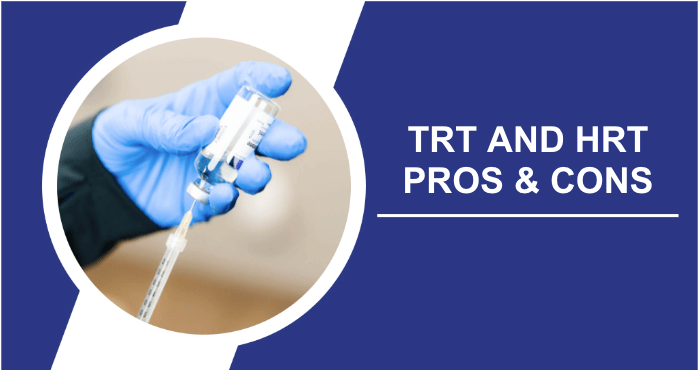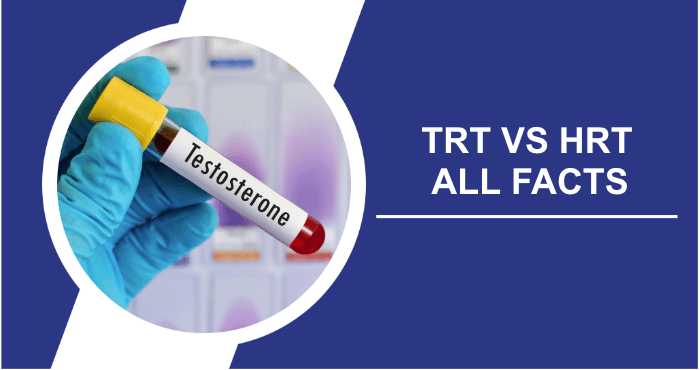Hormones function as the conductors of your body’s symphony, overseeing various aspects such as mood and muscle development. When the intricate equilibrium of your hormones becomes disrupted, a series of health issues emerges. Thankfully, within the realm of hormone regulation, two significant contenders emerge:
Hormone Replacement Therapy (HRT) and Testosterone Replacement Therapy (TRT). Within this article, we will delve into their essential distinctions, assess their advantages and disadvantages, and assist you in the decision-making process to aid you in selecting the most suitable approach for achieving optimal hormone levels and maintaining good health.
HRT Vs. TRT - Keey Points TRT (Testosterone Replacement Therapy) and HRT (Hormone Replacement Therapy) serve different purposes. TRT is designed primarily for individuals with low testosterone levels to improve energy, muscle mass, and libido. HRT, on the other hand, addresses various hormone imbalances in both men and women, targeting mood swings, hot flashes, and bone health./em>
What Are Hormones And Why Does The Body Need Them?
Hormones are like the body’s internal messengers, working behind the scenes to keep things running smoothly. They’re tiny chemicals produced by various glands in our bodies, such as the thyroid, adrenal, and pituitary glands. These messengers play a crucial role in regulating everything from our mood and metabolism to growth and reproduction.
Think of them as the conductors of a complex orchestra, making sure each instrument (organ) plays its part in harmony. Without hormones, our bodies would be like a symphony without a conductor, resulting in chaos rather than the beautiful music of life. In essence, hormones are the silent heroes that keep our bodies in balance and functioning optimally.
What Role Does Testosterone Play In Our Body?
Testosterone, often referred to as the “male hormone,” plays a crucial role in our bodies that goes beyond defining gender characteristics. It serves as a versatile messenger, influencing everything from muscle and bone growth to mood and energy levels. Testosterone contributes to the development of male sex organs during fetal development, and it continues to promote secondary sex characteristics such as facial hair and a deeper voice during puberty.
But it’s not just for men; women also produce smaller amounts of testosterone, which is essential for maintaining muscle mass and overall vitality. The intricate dance of this hormone in our bodies underscores its importance in shaping our physical and emotional well-being.
Comprehending HRT And TRT
There exists a considerable amount of confusion surrounding HRT and TRT. Let’s initiate our inquiry by elucidating the distinction between these two therapies.
What Is TRT?
Testosterone Replacement Therapy (TRT) is specifically formulated to elevate diminished testosterone levels in males. Consequently, it can be regarded as a subset of hormone replacement therapy, even though it is commonly perceived as distinct from HRT. Testosterone serves as the body’s primary androgenic hormone, governing aspects like muscle mass, bone density, mood, and sexual function. The primary objectives of TRT encompass:
- Testosterone restoration: TRT primarily aims to restore testosterone levels within a healthy range, typically between 300 ng/dL and 700 ng/dL. This is achieved by administering synthetic testosterone through various means, such as injections, patches, gels, or implantable pellets.
- Symptom alleviation: Inadequate TRT levels can induce symptoms like fatigue, diminished muscle mass, mood fluctuations, reduced bone density, and diminished libido.
What Is HRT?
Hormone Replacement Therapy (HRT) is a medical intervention designed to mitigate the manifestations of hormonal imbalance. Hormones that the body no longer produces in sufficient quantities are supplemented. It is predominantly employed to address menopause in women, with the principal hormones involved being estrogen and progesterone. The primary objectives of HRT encompass:
- Symptom alleviation: Hormonal fluctuations can lead to symptoms such as hot flashes, mood swings, sleep disturbances, fatigue, and physical frailty.
- Enhancing quality of life: HRT has the potential to significantly enhance an individual’s quality of life by increasing vitality, enhancing cognitive clarity, and fostering emotional well-being.
- Long-term health benefits: HRT may diminish the risk of osteoporosis and heart disease in menopausal women.
- Accurate testosterone measurement
- Appointment with a doctor
- Cream and injection options
- Price: $35 – $199
- Rating ⭐⭐⭐⭐⭐
Bioidentical Vs. Synthetic HRT
Hormone replacement therapy (HRT) can include either synthetic or bioidentical hormones. Here’s the difference between the two:
Bioidentical Hormones
Bioidentical hormone replacement therapy uses artificial hormones that are designed to mimic the molecular structure of hormones produced naturally by the human body. Unlike synthetic hormones, which are made entirely in a laboratory, bioidentical hormones are often derived from plant sources, with soybeans being a common choice.
The process of manufacturing bioidentical hormones, including bioidentical testosterone, begins with the extraction of the desired hormone, such as estradiol, from the plant source. It then undergoes a conversion process to achieve a molecular structure identical to that produced in the human body. These bioidentical hormones can then be formulated into various delivery forms, including creams, gels, patches, or pills.
Examples of compounded bioidentical hormones used in hormone therapy include bioidentical estradiol (a variant of estrogen) and bioidentical progesterone. Many people choose bioidentical hormones for their perceived naturalness and fewer associated side effects. The decision between synthetic and bioidentical hormone replacement therapy should also take into account an individual’s medical history, specific symptoms, and the advice of a healthcare professional.
Synthetic Hormones
Synthetic hormones are artificially synthesized versions of essential hormones that closely resemble, but are not identical to, those produced naturally by the human body. These hormones are manufactured in a laboratory. Synthetic hormones commonly used in HRT include
- Synthetic estrogens, such as ethinyl estradiol and conjugated equine estrogens.
- Synthetic progestins, including medroxyprogesterone acetate and norethindrone.
The Main Differences Between TRT And HRT
To make informed decisions regarding hormone therapy, it’s crucial to have a clear understanding of the distinctions between HRT and TRT. Here’s a breakdown:
Hormones Involved
- HRT entails the administration of multiple hormones, including estrogen and progesterone, primarily for women. In some cases, it may also encompass other hormones like thyroid hormones.
- TRT, on the other hand, specifically targets testosterone replacement in men who are experiencing andropause, characterized by declining testosterone levels.
Targeted Conditions
- HRT is primarily designed to alleviate the symptoms of menopause in women.
- TRT is focused on addressing testosterone deficiency, a condition that predominantly affects men.
Hormone Formulations
- Hormone Replacement Therapy offers various formulations, including oral medications, transdermal patches, creams, and vaginal inserts, depending on the specific hormonal needs and symptoms being addressed.
- Testosterone Replacement Therapy provides testosterone supplementation in various forms such as injections, gels, patches, or implantable pellets, with the sole aim of restoring testosterone levels.
Patient Demographics
- HRT is predominantly prescribed to women undergoing menopause, typically occurring in their late 40s to early 50s. It can also be utilized to address imbalances in thyroid hormones.
- TRT is typically recommended for men experiencing andropause, which commonly occurs in their late 40s and beyond. It is specifically intended for men diagnosed with clinically low testosterone levels.
Symptom Profiles
- HRT addresses symptoms associated with menopause, including sleep disturbances, vaginal dryness, hot flashes, and mood swings.
- TRT focuses on symptoms related to low testosterone levels, such as fatigue, reduced muscle mass, mood swings, and decreased libido.
TRT And HRT Pros And Cons

Before committing to hormone therapy, it’s essential to weigh the advantages and disadvantages of both HRT and TRT. Here are the pros and cons of each:
HRT Pros
- Relief from menopausal symptoms
- Improved overall well-being
- Increased energy, mental clarity, and emotional stability
HRT Cons
- Possible side effects like nausea, breast soreness, and irregular bleeding
- Elevated risk of certain health conditions, including blood clots and breast cancer
TRT Pros
- Enhanced energy levels
- Boosts in bone density and muscle mass
- Improved libido and sexual function
TRT Cons
- Potential side effects such as acne, mood swings, and an increased risk of cardiovascular issues
- If receiving injections, there may be complications at the injection site
TRT Vs. HRT For Men
While it is commonly understood that HRT is primarily intended for menopausal women and TRT is intended to address andropause in middle-aged men, there are situations where HRT is preferred over testosterone replacement therapy for men. Although testosterone is the hormone most affected during the natural aging process in men, it is not the only hormone affected. Other hormones affected by this natural decline may include
- DHEA (Dehydroepiandrosterone): Produced by the adrenal glands, DHEA serves as a precursor to both testosterone and estrogen.
- Pregnenolone: Often referred to as the “mother hormone,” pregnenolone acts as a precursor to several hormones, including DHEA, progesterone, estrogen, and testosterone.
- Thyroid hormones: The thyroid gland controls metabolism and energy production by releasing hormones such as thyroxine (T4) and triiodothyronine (T3). Age-related changes can affect thyroid function, resulting in symptoms such as weight fluctuations, fatigue, and mood swings.
- Growth hormone: Also known as growth hormone (GH) or human growth hormone, it plays a key role in tissue repair, muscle development, and overall vitality.
- Cortisol: Produced by the adrenal glands, cortisol is a stress hormone that regulates immune response and metabolism. Ongoing stress and age-related changes can lead to imbalances in cortisol levels.
- Melatonin: Known for its role in regulating sleep-wake cycles, melatonin has been linked to sleep disorders and altered circadian rhythms due to changes in its levels.
HRT for men aims to balance the entire spectrum of hormones in the body. Testosterone replacement therapy, on the other hand, focuses on restoring testosterone levels to a normal range.
When To Talk To Your Doctor About TRT Or HRT
If you suspect you have a hormone imbalance or low testosterone levels, it’s wise to try natural methods to restore balance before considering medical intervention. Here are ten steps you can take:
- Eat a balanced diet: Eat a variety of fruits, vegetables, lean proteins (e.g., chicken, fish, tofu), and healthy fats (e.g., nuts, avocados, olive oil). Limit processed foods, sugar, and excessive caffeine.
- Manage stress: Practice relaxation techniques such as meditation and deep breathing to reduce stress levels.
- Get regular exercise: Include resistance training, strength training, and high-intensity interval training (HIIT). Aim for at least 150 minutes of moderate aerobic activity each week.
- Achieve and maintain a healthy weight: Excess body fat can contribute to lower testosterone levels. Focus on a balanced diet and regular physical activity to achieve and maintain a healthy weight.
- Prioritize quality sleep: Aim for 7-9 hours of restful sleep each night and establish a bedtime routine to improve sleep quality.
- Stay hydrated: Ensure adequate water intake throughout the day to support overall health.
- Limit alcohol consumption: Excessive alcohol consumption can negatively affect hormone balance. Moderate your alcohol intake or consider abstaining.
- Reduce exposure to endocrine disruptors: Minimize exposure to chemicals such as BPA found in plastic containers and cans. Choose hormone-free and organic food options when available.
- Include nutrient-dense foods: Include zinc-rich foods (e.g., oysters, lean beef, pumpkin seeds) and get vitamin D from sunlight and fatty fish.
- Manage chronic health conditions: Effectively control conditions such as diabetes and high blood pressure, which can affect hormone levels.
If you continue to experience symptoms of low testosterone or hormone imbalance after making these lifestyle changes, you should make an appointment with your healthcare provider. They can evaluate your condition, perform any necessary tests, and discuss possible hormone therapy options, such as HRT or TRT, if warranted.
How To Get TRT Or HRT
To access HRT (hormone replacement therapy) or TRT (testosterone replacement therapy), it is important to follow a prescribed medical process. Here is a step-by-step guide to help you navigate the process:
Step 1: Initial Consultation
- Begin by scheduling an initial consultation with a healthcare professional, such as your primary care physician, endocrinologist, or urologist.
- During this consultation, discuss your symptoms, medical history, and any relevant family medical history.
Step 2: Testing Hormone Levels
- If your healthcare provider suspects hormone imbalances or low testosterone levels, he or she will order blood tests to measure your hormone levels.
- For HRT, these tests may include hormones such as estrogen, progesterone, and thyroid hormones.
- For TRT, the focus will be on assessing testosterone levels.
- Once your blood test results are available, you will have another consultation to review the results and identify any deficiencies or imbalances.
Step 3: Diagnosis And Treatment Recommendations
- Based on your symptoms and hormone test results, your healthcare provider will make a diagnosis regarding the underlying hormonal condition. This may include conditions such as menopause, andropause, hypogonadism, or other hormonal problems.
- Your healthcare provider will discuss treatment options with you. For HRT, this may include hormone replacement with bioidentical or synthetic hormones delivered by various methods, such as pills, patches, creams, or injections. For TRT or online testosterone therapy, testosterone replacement may be administered through injections, gels, or implantable pellets.
Step 4: Make An Informed Decision
- Your healthcare provider will give you detailed information about the potential benefits and risks of HRT or TRT.
- You will have the opportunity to ask questions and express any concerns you may have.
If you decide to proceed with hormone therapy, you will be asked to give informed consent, which means that you understand the treatment plan and accept the risks involved.
Step 5: Prescription
- Once you and your healthcare provider agree that hormone therapy is the appropriate course of action, your healthcare provider will prescribe the necessary hormones or medications.
- The prescription will specify the dosage, frequency, and method of administration.
- A detailed treatment plan will outline when and how to take or administer the prescribed hormones.
Step 6: Follow-Up Appointments
- Regular follow-up appointments will be scheduled to monitor your progress.
- Hormone levels will be retested to ensure that the treatment is effective, and any necessary adjustments can be made to optimize your therapy.
- Accurate testosterone measurement
- Appointment with a doctor
- Cream and injection options
- Price: $35 – $199
- Rating ⭐⭐⭐⭐⭐
HGH Therapy
Human Growth Hormone (HGH) Therapy is a specialized form of Hormone Replacement Therapy (HRT) designed to treat low levels of HGH in the body. The pituitary gland naturally releases HGH, which plays a critical role in various metabolic processes, cell growth, tissue regeneration, and regulation of fat metabolism. In addition, HGH contributes to muscle and bone development. As people age, both men and women often experience a natural decline in HGH production.
Low HGH levels can cause symptoms similar to those of low testosterone, including fatigue, depression, muscle loss, weight gain, sleep disturbances, and irritability. HGH therapy, administered under medical supervision and with a doctor’s prescription, is designed to counteract the effects of low HGH levels and can lead to significant improvements in overall health and body composition.
It is important to note that increasing HGH levels through therapy does not automatically increase testosterone levels. In summary, HGH therapy is a specialized treatment option for individuals diagnosed with low HGH levels and should only be pursued under the guidance of a healthcare provider.
What Are Effective Natural Alternatives To HRT And TRT?
Exploring effective natural alternatives to hormone replacement therapy (HRT) and testosterone replacement therapy (TRT) can be like discovering a holistic path to hormonal balance. A well-balanced diet rich in nutrients such as omega-3 fatty acids, antioxidants, and plant-based phytoestrogens can provide hormonal support.
Regular exercise, stress management, and quality sleep can also have a significant impact. Herbal remedies such as black cohosh, red clover, and maca root are known to ease menopausal symptoms and support hormonal health. Mind-body practices such as yoga and meditation can help manage stress and improve overall well-being. Ultimately, these natural approaches offer a gentler, more holistic way to promote hormonal harmony in the body.
Frequently Asked Questions
How do I make a choice between HRT and TRT?
The decision between HRT (Hormone Replacement Therapy) and TRT (Testosterone Replacement Therapy) hinges on factors such as your gender, symptoms, hormone levels, and overall well-being. It is crucial to engage in a discussion with a healthcare specialist who specializes in hormone therapy to explore your options and formulate an individualized treatment strategy.
What should I anticipate while undergoing HRT or TRT treatment?
Anticipate initial adjustments as your body acclimates to hormone therapy. These adjustments can manifest as changes in mood, energy levels, and relief from symptoms. Consistent check-ins with your healthcare provider play a vital role in tracking your progress and making necessary adaptations.
How long should I anticipate being on HRT or TRT?
The duration of hormone therapy varies from person to person. Some individuals may only require HRT or TRT for a limited duration, while others might necessitate long-term treatment. The duration depends on individual health objectives and medical recommendations.
Are there natural alternatives to HRT and TRT?
Certain individuals may opt for natural approaches, such as lifestyle alterations, dietary adjustments, and herbal supplements, to address hormonal imbalances. Nonetheless, the efficacy of these alternatives is variable, and they may not be suitable for every individual.
Can HRT and TRT be utilized concurrently?
In specific situations, HRT and TRT may be employed simultaneously, particularly when a transgender individual is undergoing a transition and requires both estrogen and testosterone therapy. Nevertheless, it is imperative that this combination is closely monitored by a knowledgeable healthcare provider.
Conclusion
In summary, hormone replacement therapy (HRT) and testosterone replacement therapy (TRT) are valuable tools for restoring hormonal balance. Understanding the differences between these approaches is critical to making informed decisions about your hormone health. HRT primarily addresses menopausal symptoms in women, but it can also be relevant for men with hormonal imbalances. TRT, on the other hand, focuses specifically on increasing testosterone levels in men.
Before considering medical intervention for hormone issues, it’s wise to make natural lifestyle adjustments to support hormone balance. If symptoms persist, consultation with a healthcare provider is essential. Hormone therapy should always be used under the guidance and supervision of a qualified healthcare professional who can accurately diagnose hormone imbalances, discuss treatment options, and monitor progress.
Fountain TRT offers a comprehensive online testosterone replacement therapy service that provides a convenient and patient-centered approach for men dealing with low testosterone levels. Their process, which includes initial assessments, blood tests, and consultations with urologists, offers a streamlined path to TRT.
Sources
- Hormone-replacement therapy: current thinking. doi: 10.1038/nrendo.2016.164 Read more
- Testosterone replacement therapy. doi: 10.1111/andr.12774 Read more
- Testosterone replacement therapy: For whom, when and how? doi: 10.1016/j.metabol.2018.03.007 Read more
- Testosterone: a metabolic hormone in health and disease. doi: 10.1530/JOE-12-0455 Read more
Jayson Peterson is an experienced pharmacist, naturopathic physician, medical examiner, and minister. After earning his Doctor of Pharmacy degree from the Medical University of South Carolina, Jayson Peterson completed clinical rotations at several prestigious healthcare institutions and has been affiliated with several pharmacy chains throughout his career. His main passion and zeal is focused on providing world-class patient care by giving precise details and thorough instructions to those who need it most.


